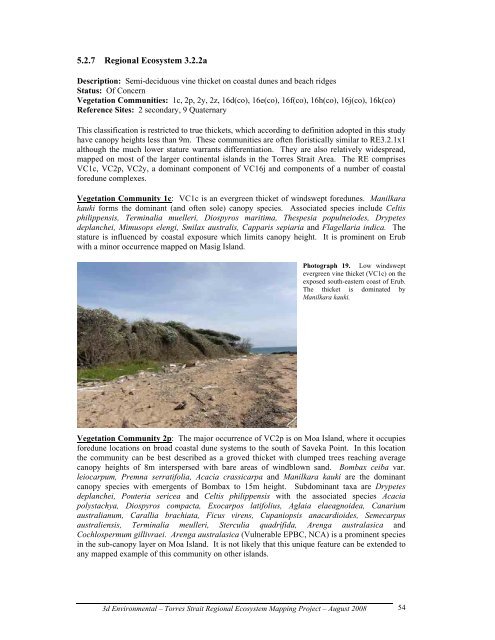Appendix 2 - Vegetation Communities and Regional Ecosystems
Appendix 2 - Vegetation Communities and Regional Ecosystems
Appendix 2 - Vegetation Communities and Regional Ecosystems
Create successful ePaper yourself
Turn your PDF publications into a flip-book with our unique Google optimized e-Paper software.
5.2.7 <strong>Regional</strong> Ecosystem 3.2.2a<br />
Description: Semi-deciduous vine thicket on coastal dunes <strong>and</strong> beach ridges<br />
Status: Of Concern<br />
<strong>Vegetation</strong> <strong>Communities</strong>: 1c, 2p, 2y, 2z, 16d(co), 16e(co), 16f(co), 16h(co), 16j(co), 16k(co)<br />
Reference Sites: 2 secondary, 9 Quaternary<br />
This classification is restricted to true thickets, which according to definition adopted in this study<br />
have canopy heights less than 9m. These communities are often floristically similar to RE3.2.1x1<br />
although the much lower stature warrants differentiation. They are also relatively widespread,<br />
mapped on most of the larger continental isl<strong>and</strong>s in the Torres Strait Area. The RE comprises<br />
VC1c, VC2p, VC2y, a dominant component of VC16j <strong>and</strong> components of a number of coastal<br />
foredune complexes.<br />
<strong>Vegetation</strong> Community 1c: VC1c is an evergreen thicket of windswept foredunes. Manilkara<br />
kauki forms the dominant (<strong>and</strong> often sole) canopy species. Associated species include Celtis<br />
philippensis, Terminalia muelleri, Diospyros maritima, Thespesia populneiodes, Drypetes<br />
deplanchei, Mimusops elengi, Smilax australis, Capparis sepiaria <strong>and</strong> Flagellaria indica. The<br />
stature is influenced by coastal exposure which limits canopy height. It is prominent on Erub<br />
with a minor occurrence mapped on Masig Isl<strong>and</strong>.<br />
Photograph 19. Low windswept<br />
evergreen vine thicket (VC1c) on the<br />
exposed south-eastern coast of Erub.<br />
The thicket is dominated by<br />
Manilkara kauki.<br />
<strong>Vegetation</strong> Community 2p: The major occurrence of VC2p is on Moa Isl<strong>and</strong>, where it occupies<br />
foredune locations on broad coastal dune systems to the south of Saveka Point. In this location<br />
the community can be best described as a groved thicket with clumped trees reaching average<br />
canopy heights of 8m interspersed with bare areas of windblown s<strong>and</strong>. Bombax ceiba var.<br />
leiocarpum, Premna serratifolia, Acacia crassicarpa <strong>and</strong> Manilkara kauki are the dominant<br />
canopy species with emergents of Bombax to 15m height. Subdominant taxa are Drypetes<br />
deplanchei, Pouteria sericea <strong>and</strong> Celtis philippensis with the associated species Acacia<br />
polystachya, Diospyros compacta, Exocarpos latifolius, Aglaia elaeagnoidea, Canarium<br />
australianum, Carallia brachiata, Ficus virens, Cupaniopsis anacardioides, Semecarpus<br />
australiensis, Terminalia meulleri, Sterculia quadrifida, Arenga australasica <strong>and</strong><br />
Cochlospermum gillivraei. Arenga australasica (Vulnerable EPBC, NCA) is a prominent species<br />
in the sub-canopy layer on Moa Isl<strong>and</strong>. It is not likely that this unique feature can be extended to<br />
any mapped example of this community on other isl<strong>and</strong>s.<br />
3d Environmental – Torres Strait <strong>Regional</strong> Ecosystem Mapping Project – August 2008<br />
54


